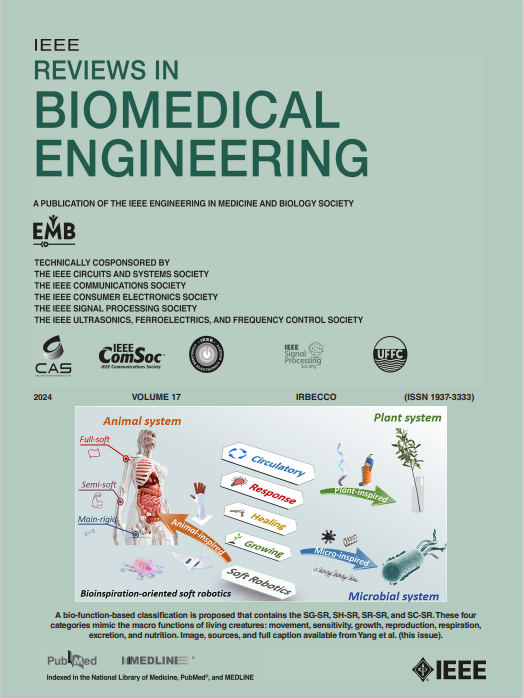Radiomics and Deep Learning in Nasopharyngeal Carcinoma: A Review
IF 17.2
1区 工程技术
Q1 ENGINEERING, BIOMEDICAL
引用次数: 0
Abstract
Nasopharyngeal carcinoma is a common head and neck malignancy with distinct clinical management compared to other types of cancer. Precision risk stratification and tailored therapeutic interventions are crucial to improving the survival outcomes. Artificial intelligence, including radiomics and deep learning, has exhibited considerable efficacy in various clinical tasks for nasopharyngeal carcinoma. These techniques leverage medical images and other clinical data to optimize clinical workflow and ultimately benefit patients. In this review, we provide an overview of the technical aspects and basic workflow of radiomics and deep learning in medical image analysis. We then conduct a detailed review of their applications to seven typical tasks in the clinical diagnosis and treatment of nasopharyngeal carcinoma, covering various aspects of image synthesis, lesion segmentation, diagnosis, and prognosis. The innovation and application effects of cutting-edge research are summarized. Recognizing the heterogeneity of the research field and the existing gap between research and clinical translation, potential avenues for improvement are discussed. We propose that these issues can be gradually addressed by establishing standardized large datasets, exploring the biological characteristics of features, and technological upgrades.鼻咽癌放射组学与深度学习:综述
鼻咽癌是一种常见的头颈部恶性肿瘤,与其他类型的癌症相比,其临床治疗方法截然不同。精准的风险分层和量身定制的治疗干预对改善生存结果至关重要。人工智能,包括放射组学和深度学习,在鼻咽癌的各种临床任务中表现出了相当大的功效。这些技术利用医学影像和其他临床数据来优化临床工作流程,最终使患者受益。在本综述中,我们将概述放射组学和深度学习在医学图像分析中的技术方面和基本工作流程。然后,我们详细回顾了它们在鼻咽癌临床诊断和治疗的七项典型任务中的应用,涵盖了图像合成、病灶分割、诊断和预后等各个方面。总结了前沿研究的创新和应用效果。认识到研究领域的异质性以及研究与临床转化之间存在的差距,讨论了潜在的改进途径。我们提出,可以通过建立标准化的大型数据集、探索特征的生物学特性以及技术升级来逐步解决这些问题。
本文章由计算机程序翻译,如有差异,请以英文原文为准。
求助全文
约1分钟内获得全文
求助全文
来源期刊

IEEE Reviews in Biomedical Engineering
Engineering-Biomedical Engineering
CiteScore
31.70
自引率
0.60%
发文量
93
期刊介绍:
IEEE Reviews in Biomedical Engineering (RBME) serves as a platform to review the state-of-the-art and trends in the interdisciplinary field of biomedical engineering, which encompasses engineering, life sciences, and medicine. The journal aims to consolidate research and reviews for members of all IEEE societies interested in biomedical engineering. Recognizing the demand for comprehensive reviews among authors of various IEEE journals, RBME addresses this need by receiving, reviewing, and publishing scholarly works under one umbrella. It covers a broad spectrum, from historical to modern developments in biomedical engineering and the integration of technologies from various IEEE societies into the life sciences and medicine.
 求助内容:
求助内容: 应助结果提醒方式:
应助结果提醒方式:


